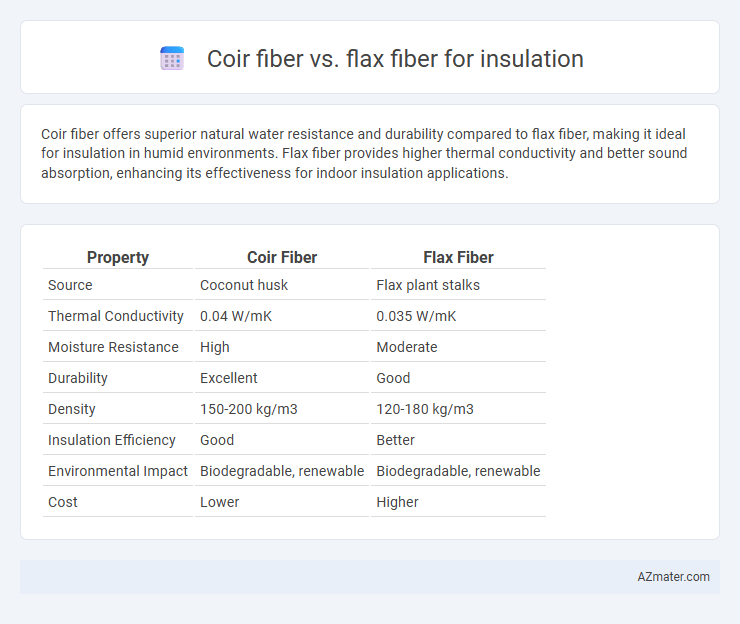Coir fiber offers superior natural water resistance and durability compared to flax fiber, making it ideal for insulation in humid environments. Flax fiber provides higher thermal conductivity and better sound absorption, enhancing its effectiveness for indoor insulation applications.
Table of Comparison
| Property | Coir Fiber | Flax Fiber |
|---|---|---|
| Source | Coconut husk | Flax plant stalks |
| Thermal Conductivity | 0.04 W/mK | 0.035 W/mK |
| Moisture Resistance | High | Moderate |
| Durability | Excellent | Good |
| Density | 150-200 kg/m3 | 120-180 kg/m3 |
| Insulation Efficiency | Good | Better |
| Environmental Impact | Biodegradable, renewable | Biodegradable, renewable |
| Cost | Lower | Higher |
Introduction to Natural Fiber Insulation
Natural fiber insulation utilizes sustainable materials like coir fiber and flax fiber, known for their excellent thermal and acoustic properties. Coir fiber, derived from coconut husks, offers superior moisture resistance and durability, making it ideal for humid environments. Flax fiber insulation provides lightweight, biodegradable benefits with high thermal resistance and natural mold protection, supporting eco-friendly building solutions.
Overview of Coir Fiber
Coir fiber, derived from the husk of coconut shells, offers excellent thermal insulation due to its natural resilience, moisture resistance, and high durability, making it a sustainable alternative to synthetic materials. It has a low thermal conductivity value, typically around 0.04 W/mK, which enhances its effectiveness in reducing heat transfer in building insulation. Compared to flax fiber, coir provides superior resistance to microbial degradation and retains its insulating properties even in humid conditions.
Overview of Flax Fiber
Flax fiber, derived from the stalks of the flax plant, offers exceptional thermal insulation properties due to its low thermal conductivity and moisture-regulating capabilities. It is biodegradable, lightweight, and provides good sound absorption, making it an eco-friendly alternative to synthetic insulation materials. Compared to coir fiber, flax fiber typically exhibits higher tensile strength and better insulation efficiency, enhancing energy conservation in buildings.
Thermal Insulation Properties: Coir vs Flax
Coir fiber exhibits a higher thermal resistance due to its natural hollow structure, which traps air efficiently and reduces heat transfer, making it an effective insulation material. Flax fiber, while possessing good thermal insulation properties, has a denser composition that provides moderate thermal resistance but excels in moisture regulation and durability. Comparing the two, coir offers superior thermal insulation performance for maintaining consistent indoor temperatures in building applications.
Acoustic Insulation Performance Comparison
Coir fiber offers superior acoustic insulation properties due to its high density and natural porosity, which effectively absorb and dampen sound waves in building applications. Flax fiber, while providing decent sound absorption, typically exhibits lower acoustic performance compared to coir, primarily because of its finer fiber structure and less compact fiber mat. Studies indicate coir fiber insulation can reduce noise levels by up to 50% more than flax fiber in similar wall and ceiling installations, making it a preferred choice for soundproofing in sustainable construction.
Environmental Impact and Sustainability
Coir fiber, derived from coconut husks, is highly sustainable due to its natural biodegradability and the utilization of agricultural waste, minimizing environmental impact. Flax fiber, obtained from flax plants, offers excellent insulation qualities with low embodied energy and is fully biodegradable, promoting soil health through crop rotation. Both fibers contribute to eco-friendly insulation solutions, but Coir fiber's waste-recycling aspect provides a slight edge in circular economy benefits.
Durability and Lifespan of the Fibers
Coir fiber, derived from coconut husks, exhibits superior durability and resistance to moisture, making it ideal for insulation applications in humid environments. Flax fiber, while providing excellent thermal insulation due to its natural cell structure, tends to have a shorter lifespan because of its susceptibility to mold and insect damage. The extended durability of coir fiber contributes to a longer-lasting insulating material compared to flax fiber in most conditions.
Installation and Handling Considerations
Coir fiber insulation offers lightweight handling and easy installation due to its natural flexibility and resistance to moisture, reducing the risk of mold during application. Flax fiber insulation requires careful moisture control and protective gear during installation because of its denser structure and potential allergenic properties. Both materials demand precise cutting and fitting techniques to ensure optimal thermal performance and minimize fiber breakage.
Cost Effectiveness: Coir vs Flax
Coir fiber insulation offers cost-effectiveness due to its abundant availability and low production expenses, making it a budget-friendly choice for sustainable building projects. Flax fiber insulation, while generally more expensive, provides higher thermal performance and durability, potentially reducing long-term costs through energy savings and material longevity. Comparing raw material costs and lifecycle efficiency reveals coir's advantage in initial investment, whereas flax fiber delivers value through enhanced insulation quality over time.
Best Applications for Each Fiber Type
Coir fiber offers excellent moisture resistance and durability, making it ideal for insulation in humid climates and areas prone to water exposure such as basements and coastal buildings. Flax fiber provides superior thermal and acoustic insulation properties with a lightweight and breathable structure, suitable for indoor wall insulation and eco-friendly residential construction. Both fibers are biodegradable and sustainable, but coir excels in outdoor or moisture-challenged environments, while flax performs best in dry, temperature-controlled spaces.

Infographic: Coir fiber vs Flax fiber for Insulation
 azmater.com
azmater.com